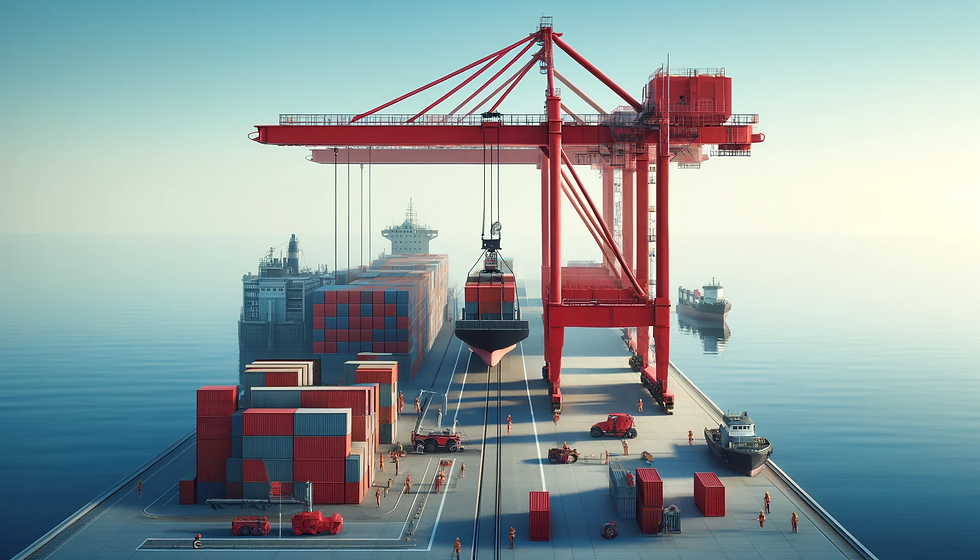Case Studies in Success: How Portal Cranes are Revolutionizing Ports Worldwide
- Tian

- Apr 9, 2024
- 3 min read
In the intricate dance of global commerce, efficiency, and speed are the rhythms by which ports operate. Integral to this process are portal cranes, the towering workhorses of the maritime industry. This blog post explores how portal cranes have become pivotal in transforming port operations across the globe, focusing on case studies that highlight their impact.
The Backbone of Modern Ports: An Introduction to Portal Cranes
Portal cranes, characterized by their large size and towering height, are designed to quickly load and unload cargo from ships. These cranes move on rails, allowing them to traverse the length of the port for optimal positioning. With advancements in technology, modern portal cranes boast features like automation, enhanced load capacities, and environmentally friendly operations, setting new standards in port efficiency.
Case Study 1: The Port of Singapore – A Model of Efficiency
The Port of Singapore, one of the busiest in the world, has consistently set benchmarks for operational excellence. A significant contributor to this success is the deployment of state-of-the-art portal cranes equipped with intelligent technologies. These cranes have enabled the port to handle the immense cargo volume with precision and minimal downtime.
Key Innovations:
Automation: Automated portal cranes in Singapore can identify and move containers without human intervention, significantly reducing loading and unloading times.
Sustainability: The port's portal cranes are powered by electricity, reducing the carbon footprint associated with cargo handling.
Case Study 2: The Port of Rotterdam – Embracing Sustainability
The Port of Rotterdam, Europe's largest, has taken significant strides towards sustainability, with portal cranes playing a crucial role. The cranes here are not just tools for moving cargo; they are part of a larger eco-friendly initiative to create a sustainable port environment.
Sustainability Efforts:
Energy Efficiency: The portal cranes utilize regenerative energy systems, capturing energy while transporting cargo and reusing it, thereby reducing energy consumption.
Eco-friendly Operations: These cranes operate with minimal noise pollution and zero emissions, aligning with the port's green objectives.
Case Study 3: The Port of Los Angeles – Technological Advancements
The Port of Los Angeles, a key gateway for international trade in the United States, has leveraged technology to enhance the capabilities of its portal cranes. These advancements have increased operational efficiency and ensured worker safety.
Technological Enhancements:
Remote Operation: Operators can control cranes remotely from a centralized location, reducing the risk of accidents and improving efficiency.
Advanced Monitoring Systems: Equipped with sensors and AI, the portal cranes can predict maintenance needs, preventing downtime and extending the lifespan of the equipment.
The Impact of Portal Cranes: A Global Perspective
Across the globe, the adoption of advanced portal cranes is reshaping port operations. The benefits are manifold:
Increased Operational Efficiency: Faster loading and unloading times translate to shorter turnaround times for ships, enhancing port throughput.
Reduced Environmental Impact: Energy-efficient and emission-free operations contribute to the sustainability goals of ports.
Enhanced Safety: Automation and remote operation capabilities minimize the risk of workplace accidents.
Looking Ahead: The Future of Port Operations
As the global trade landscape continues to evolve, the role of portal cranes in ports worldwide is set to become even more critical. With ongoing technological advancements, the future points towards fully automated ports where portal cranes operate in seamless coordination, driven by AI and machine learning.
In conclusion, the case studies of Singapore, Rotterdam, and Los Angeles exemplify the revolutionary impact of portal cranes on port operations. As we progress, these cranes will continue to be at the forefront of innovation, driving efficiency, sustainability, and safety in the maritime industry. The journey of portal cranes is not just about technological advancement but about setting a new course for the future of global commerce.







Comments